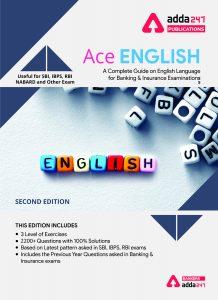Directions (1-10): Read the following passage carefully and answer the questions given below them. Certain words/phrases have been printed in bold to help you locate them while answering some of the questions.
Paragraph 1: There is a school of thought that is concerned about the extremes of capitalism that have given rise to morally reprehensible practices by large enterprises. These range from predatory lending and market manipulation in the financial sector to tech companies’ abuse of personal data and emissions cheating in the automobile industry. They threaten trust and cooperation, which is the foundation of well-being and productivity. An alternative to these extremes is to expand and embrace the broad base provided by small enterprises, which is the biggest segment. This will not only provide a foundation to their well-being, but also increase productivity and jobs. There is another school of thought that small is not beautiful. Small enterprises are not productive, create bad jobs, and are not connected with the rapidly changing forces of urbanization, globalization, and technology.
Paragraph 2: How have formal enterprises impacted informal enterprises in India, and vice versa? Empirical evidence suggests that there are strong positive linkages, and spillovers, between small and large enterprises. Small firms in the unorganized sector are important suppliers of inputs to large firms in the organized sector. Employment and output in the organized sector are greater in those states in India that have a greater presence of unorganized suppliers of inputs. A 10% rise in employment of unorganized sector suppliers increases the employment of organized sector buyers by 16%.
Paragraph 3: Higher quality in small enterprises does not squeeze the size of the large firms by providing an incentive for enterprises to stay small. Instead, boosts in total factor productivity of small enterprises in the unorganized sector in supplying industries in turn boosts the real output in the organized sector. And sectors that depend on large enterprises tend to have more productive small enterprises of the unorganized variety. This is because as large enterprises get more productive, they also demand higher quality inputs from smaller enterprises. Small enterprises respond by expanding their employment.
Paragraph 4: An important concern for policymakers is that growth in the manufacturing sector is turning out to be “jobless growth”. Large- scale manufacturing enterprises tend to be more skill- intensive. Most of the employment generation occurs in small and medium enterprises, in organized and unorganized sectors, and in ancillary plants that are linked with large-scale factories. Even in highly industrialized states like Gujarat that have attracted and retained large-scale manufacturing, employment growth has been disappointing, as ancillary plants have not grown.
Paragraph 5: Small enterprises account for the majority of jobs in India. Much of India’s urbanization is occurring through small, informal enterprises as they move into cities in search of better infrastructure. Conversely, large enterprises—especially land-intensive enterprises in the manufacturing sector—are moving out of cities and into rural areas in search of lower land costs to remain competitive. Thus, an inclusionary rather than exclusionary approach to the urban informal economy is needed. There should be adequate provision of city infrastructure to aid informal enterprises. Cities should find ways to ensure that urban informal jobs are integrated into urban plans, land allocation, and zoning regulations, that the urban informal workforce gains access to markets, and that organizations of informal workers are invited to participate in procurement schemes and policymaking processes. The more that Indian cities recognize this influx, and design appropriate policies and investments to support it, the more effective the policy interventions will be. A bottom-up approach will be more effective than a top-down approach.
Q1. What is/ are the different outlook (s) related to large and small enterprises discussed in paragraph 1?
(I) Rise of capitalism advocates malpractices by large enterprises.
(II) Both large and small enterprises affect urbanization, globalization and technology of a country.
(III) Small enterprises do not contribute growth of the economy.
(a) Only (I)
(b) Both (I) and (II)
(c) Only (II)
(d) Both (I) and (III)
(e) All are correct
Q2. According to the passage, are small and large enterprises friends or foes? And How?
(I) Friends, as small enterprises are source of various resources to large enterprises.
(II) Foes, as both are providing a competitive environment to each other.
(III) Friends, as both small and large enterprises are linked positively with each other.
(IV) Foes, as large enterprises dominate small enterprises in organized sector.
(a) Only (II)
(b) Both (II) and (IV)
(c) Only (I)
(d) Both (I) and (III)
(e) Only (IV)
Q3. How is it correct to say that the two sectors nurture each other?
(a) Higher the productivity of large enterprises, greater will be the demand of inputs from smaller enterprises.
(b) total factor productivity of small enterprises boosts the real output of large enterprises.
(c) The large enterprises enable job creation affecting the small enterprises.
(d) Both (a) and (b)
(e) All of the above
Q4. Why are there majority of jobs in small enterprises as compared to large enterprises?
(a) As large enterprises require large capital to withhold large labour.
(b) As there is lack of assistance by government to large enterprises.
(c) As there is lack of adequate resources in large enterprises.
(d) As large- scale enterprises need skilled labour which is lacking in India.
(e) All of the above
Q5. Which bottom- up approach has been defined in the passage?
(a) Trade among other countries is needed by both the enterprises.
(b) To remain competitive, there is need to enhance their enterprises by empowering every citizen.
(c) to overcome the challenges faced by small and large enterprises, there is need to ensure better city infrastructure and land allocation to the respective enterprises.
(d) Adequate skills need to be imparted in the Indian workers.
(e) All of the above.
Q6. The appropriate title of the passage is
(a) The inclusionary and exclusionary approach
(b) The changing forces of Urbanization, Globalization, and Technology.
(c) The organized and unorganized sector enterprises
(d) The jobless growth
(e) Informal enterprises should be encouraged
Q7. Which of the following alternatives among the five options provides the most similar meaning(s) of the word given in BOLD as used in the passage?
Reprehensible
(I) culpable
(II) flounder
(III) abject
(IV) deplorable
(a) Only (I) and (IV)
(b) Only (II) and (III)
(c) Only (I), (II) and (IV)
(d) Only (II), (III) and (IV)
(e) All are correct
Q8. Which of the following alternatives among the five options provides the most similar meaning(s) of the word given in BOLD as used in the passage?
Ancillary
(I) axiomatic
(II) auxiliary
(III) subsidiary
(IV) subdued
(a) Only (I) and (IV)
(b) Only (II) and (III)
(c) Only (I), (II) and (IV)
(d) Only (II), (III) and (IV)
(e) All are correct
Q9. Which of the following alternatives among the five options provides the most opposite meaning(s) of the word given in BOLD as used in the passage?
Boost
(I) inundate
(II) hinder
(III) dissuade
(IV) extraneous
(a) Only (I) and (IV)
(b) Only (II) and (III)
(c) Only (I), (II) and (IV)
(d) Only (II), (III) and (IV)
(e) All are correct
Q10. Which of the following alternatives among the five options provides the most opposite meaning(s) of the word given in BOLD as used in the passage?
Provision
(I) entrench
(II) taper
(III) rile
(IV) harness
(a) Only (I) and (III)
(b) Only (I) and (II)
(c) Only (I), (II) and (IV)
(d) Only (II), (III) and (IV)
(e) None of these
Directions (11-15): In each of the questions given below four words are given in bold. These four words may or may not be in their correct position. The sentence is then followed by options with the correct combination of words that should replace each other in order to make the sentence grammatically and contextually correct. Find the correct combination of the words that replace each other. If the sentence is correct as it is then select option (e) as your choice.
Q11. Emerging (1) markets are advanced (2) their dynamism, after a remarkable (3) three-decade-long run during which they caught up rapidly with losing (4) economies.
(a) 1-2
(b) 2-3
(c) 2-4
(d) 1-3
(e) None of these
Q12. The protracted (1) economic forecasts (2) from the International Monetary Fund and the World Bank are sobering (3), pointing to latest (4) slowdowns across the board in China, India, Sub-Saharan Africa, and Latin America.
(a) 1-4
(b) 2-3
(c) 3-4
(d) Both (a) & (c)
(e) None of these
Q13. It’s nice to see that the government borrowing (1) its plan to raise part of its annual (2) gross junked (3) overseas in foreign currencies but the ~70,000crore recapitalization (4) package of public sector banks has not achieved the purpose.
(a) 1-2
(b) 2-3
(c) 2-4
(d) 1-3
(e) None of these
Q14. To meet the minimum capital adequacy norms (1) set by RBI and to operations (2) the banks to expand their enable (3), public sector banks will need more capital (4).
(a) 1-4
(b) 2-3
(c) 3-4
(d) Both (a) & (c)
(e) None of these
Q15. People might be relied (1) to understand to what extent (2) opinion polls can be struggling (3) on, at least so far as the Delhi Assembly election is concerned (4).
(a) 1-2
(b) 2-3
(c) 2-4
(d) 1-3
(e) None of these
Solutions
S1. Ans. (d)
Sol. In paragraph 1, the phrase ‘school of thought’ has been used which means a particular way of thinking or opinion. Hence, we can point out that two school of thoughts are discussed in paragraph 1, first is the demerits of capitalism and second is of small enterprises.
Hence, we can mark option (d) as our correct choice.
Refer the lines “There is a school of thought that is concerned about the extremes of capitalism that have given rise to morally reprehensible practices by large enterprises.”
“There is another school of thought that small is not beautiful. Small enterprises are not productive, create bad jobs, and are not connected with the rapidly changing forces of urbanization, globalization, and technology.”
S2. Ans. (d)
Sol. Paragraph 2 will provide the requisite answer. It has been stated that there is a strong positive linkage between the small and large enterprises, which clearly indicates that both are friends.
Hence both the statements (I) and (III) are correct.
Refer the lines “Empirical evidence suggests that there are strong positive linkages, and spillovers, between small and large enterprises.”
“Small firms in the unorganized sector are important suppliers of inputs to large firms in the organized
sector.”
S3. Ans. (d)
Sol. Refer the third paragraph of the passage from which we can conclude that small and large enterprises nurture each other.
Sentence (c) is irrelevant with respect to the passage.
Hence, option (d) is the most appropriate choice.
Refer the lines “Instead, boosts in total factor productivity of small enterprises in the unorganized sector in supplying industries in turn boosts the real output in the organized sector.”
“This is because as large enterprises get more productive, they also demand higher quality inputs from smaller enterprises.”
S4. Ans. (d)
Sol. We can derive our conclusion from paragraph 4 that talks about jobless growth with rise in manufacturing sector in India as large enterprises tend to be skill intensive.
Hence only statement (d) supports the context of the paragraph proving it to be the correct choice.
Refer the lines “Large- scale manufacturing enterprises tend to be more skill- intensive. Most of the employment generation occurs in small and medium enterprises, in organized and unorganized sectors, and in ancillary plants that are linked with large-scale factories.”
S5. Ans. (c)
Sol. Refer the fifth paragraph of the passage in which it is clearly mentioned the bottom- up approach to overcome the challenges of small and large enterprises (infrastructure and land scarcity respectively).
Hence option (c) is the most appropriate choice.
Refer the lines “There should be adequate provision of city infrastructure to aid informal enterprises. Cities should find ways to ensure that urban informal jobs are integrated into urban plans, land allocation, and zoning regulations, that the urban informal workforce gains access to markets, and that organizations of informal workers are invited to participate in procurement schemes and policymaking processes.”
S6. Ans. (e)
Sol. “Informal enterprises should be encouraged” is an appropriate title of the passage.
S7. Ans. (a)
Sol. Reprehensible means deserving censure or condemnation. Hence it has same meaning as deplorable and culpable.
Abject means extremely unpleasant and degrading.
Flounder means struggle.
S8. Ans. (b)
Sol. Ancillary means in addition to something else, but not as important. Hence it has same meaning as auxiliary and subsidiary.
Subdued means quiet and rather reflective or depressed.
Axiomatic means self- evident or unquestionable.
S9. Ans. (b)
Sol. Boost means help or encourage (something) to increase or improve. Hence it has opposite meaning as hinder and dissuade.
Extraneous means irrelevant or unelated.
Inundate means overwhelm (someone) with things or people to be dealt with.
S10. Ans. (e)
Sol. Provision means the action of providing or supplying something for use. No word is opposite in meaning to it.
Taper means diminish or reduce in thickness.
Harness means control and tackle.
Rile means make annoyed or irritated.
Entrench means establish or settle.
S11. Ans. (c)
Sol. Here, 2-4i.e, ‘losing’ will be replaced by ‘advanced’ to make the sentence grammatically and contextually correct. The sentence thus formed is,
“Emerging markets are losing their dynamism, after a remarkable three-decade-long run during which they caught up rapidly with advanced economies”.
S12. Ans. (a)
Sol. Here, 1-4i.e, ‘latest’ will be replaced by ‘protracted’ to make the sentence grammatically and contextually correct. The sentence thus formed is,
“The latest economic forecasts from the International Monetary Fund and the World Bank are sobering, pointing to protracted slowdowns across the board in China, India, Sub-Saharan Africa, and Latin America”.
S13. Ans. (d)
Sol. Here, 1-3 i.e, ‘junked’ will be replaced by ‘borrowing’ to make the sentence grammatically and contextually correct. The sentence thus formed is,
“It’s nice to see that the government junked its plan to raise part of its annual gross borrowing overseas in foreign currencies but the ~70,000crore recapitalization package of public sector banks has not achieved the purpose”.
S14. Ans. (b)
Sol. Here, 2-3 i.e, ‘enable’ will be replaced by ‘operations’ to make the sentence grammatically and contextually correct. The sentence thus formed is,
“To meet the minimum capital adequacy norms set by RBI and to enable the banks to expand their operations, public sector banks will need more capital”.
S15. Ans. (d)
Sol. Here, 1-3i.e, ‘struggling’ will be replaced by ‘relied’ to make the sentence grammatically and contextually correct. The sentence thus formed is,
“Another Assembly election in Delhi is around the corner. People might be struggling to understand to what extent opinion polls can be relied on, at least so far as the Delhi Assembly election is concerned”.
Click Here to Register for Bank Exams 2021 Preparation Material




 English Language Quiz For Bank Foundatio...
English Language Quiz For Bank Foundatio...
 English Language Quiz For Bank Mains Exa...
English Language Quiz For Bank Mains Exa...



